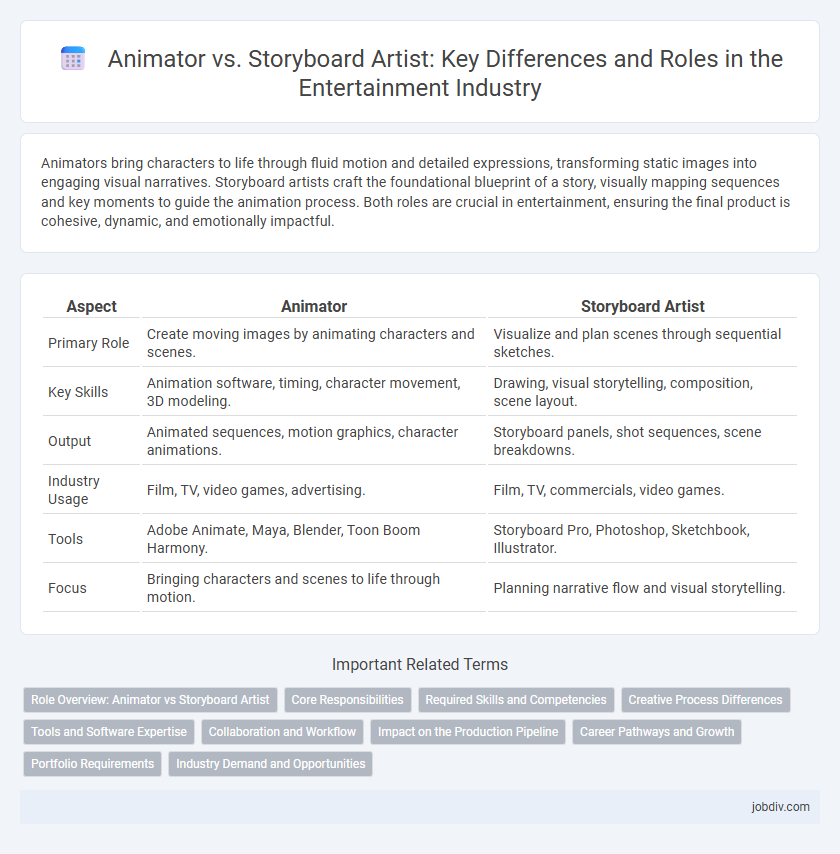Animators bring characters to life through fluid motion and detailed expressions, transforming static images into engaging visual narratives. Storyboard artists craft the foundational blueprint of a story, visually mapping sequences and key moments to guide the animation process. Both roles are crucial in entertainment, ensuring the final product is cohesive, dynamic, and emotionally impactful.
Table of Comparison
| Aspect | Animator | Storyboard Artist |
|---|---|---|
| Primary Role | Create moving images by animating characters and scenes. | Visualize and plan scenes through sequential sketches. |
| Key Skills | Animation software, timing, character movement, 3D modeling. | Drawing, visual storytelling, composition, scene layout. |
| Output | Animated sequences, motion graphics, character animations. | Storyboard panels, shot sequences, scene breakdowns. |
| Industry Usage | Film, TV, video games, advertising. | Film, TV, commercials, video games. |
| Tools | Adobe Animate, Maya, Blender, Toon Boom Harmony. | Storyboard Pro, Photoshop, Sketchbook, Illustrator. |
| Focus | Bringing characters and scenes to life through motion. | Planning narrative flow and visual storytelling. |
Role Overview: Animator vs Storyboard Artist
Animators bring characters and scenes to life through detailed movement and expression, crafting fluid sequences that enhance storytelling. Storyboard artists focus on visualizing the narrative structure by creating a series of sketches that outline key scenes, camera angles, and action progression. These complementary roles combine artistic skill with storytelling insight to shape the final visual experience in film, television, and digital media.
Core Responsibilities
Animators are responsible for creating fluid and expressive character movements using specialized software, focusing on performance and timing to bring scenes to life. Storyboard artists develop visual blueprints by sketching key scenes and camera angles, ensuring narrative flow and pacing align with the script. Both roles require collaboration with directors and production teams to maintain consistency and enhance storytelling quality throughout the animation process.
Required Skills and Competencies
Animators require strong proficiency in character movement, timing, and expression, combined with expertise in animation software such as Maya, Toon Boom, or Blender to bring stories to life visually. Storyboard artists excel in visual storytelling, scene composition, and pacing, utilizing skills in drawing, sketching, and story development tools like Storyboard Pro to map out sequences effectively. Both roles demand creativity, attention to detail, collaboration, and a deep understanding of narrative flow to ensure seamless production in film, television, and video games.
Creative Process Differences
Animators focus on bringing characters and scenes to life through movement, emphasizing timing, fluidity, and expression to create engaging sequences. Storyboard artists concentrate on visual storytelling by designing key frames and layouts that establish narrative flow, composition, and pacing. The creative process diverges as animators translate static images into dynamic motion, while storyboard artists develop the visual blueprint that guides the entire animation production.
Tools and Software Expertise
Animators primarily utilize tools such as Autodesk Maya, Adobe After Effects, and Toon Boom Harmony to create fluid character movements and detailed animations. Storyboard artists rely heavily on software like Storyboard Pro, Photoshop, and Clip Studio Paint to develop visual narratives and plan scenes effectively. Mastery in both traditional sketching techniques and digital platforms like Wacom tablets enhances the capabilities of animators and storyboard artists in producing high-quality visual storytelling.
Collaboration and Workflow
Animators and storyboard artists collaborate closely to ensure seamless storytelling and visual continuity in animated productions. Storyboard artists create detailed frames that guide animators in timing, movement, and scene composition, streamlining the creative workflow and reducing revisions. This symbiotic relationship enhances efficiency and quality, ultimately bringing dynamic narratives to life with precision and artistic coherence.
Impact on the Production Pipeline
Animators bring characters to life through detailed motion and expression, influencing the timing and emotional depth of scenes, while storyboard artists establish the narrative flow and visual structure that guide the entire production. Their collaboration shapes the efficiency and clarity of communication between departments, reducing revisions and streamlining the animation process. Effective synchronization between animators and storyboard artists accelerates the pipeline, ensuring a cohesive final product aligned with the director's vision.
Career Pathways and Growth
Animators typically specialize in character movement and visual storytelling through motion, developing skills in software like Maya or Blender which open opportunities in film, television, and gaming industries. Storyboard artists focus on pre-visualization by creating visual plans of scenes, requiring strong drawing skills and knowledge of narrative structure, often advancing into roles such as director or production designer. Both career paths offer growth through mastering industry-standard tools, understanding visual storytelling techniques, and building a diverse portfolio that can lead to leadership positions in animation studios.
Portfolio Requirements
Animators require a portfolio showcasing fluid character motion, diverse animation techniques, and strong understanding of timing and spacing, highlighting 2D or 3D animation reels with completed projects. Storyboard artists must present a portfolio emphasizing clear visual storytelling, dynamic composition, and sequence development, including thumbnails, key frames, and finished storyboard panels. Both portfolios benefit from demonstrating versatility, creativity, and proficiency in industry-standard software such as Toon Boom, Adobe Animate, or Storyboard Pro.
Industry Demand and Opportunities
The entertainment industry increasingly values both animators and storyboard artists, as each plays a crucial role in content creation and visual storytelling. Animators are in high demand for their skills in bringing characters and scenes to life through motion, especially with the rise of digital animation and gaming sectors. Storyboard artists are essential for pre-visualizing narratives, ensuring efficient production processes and clear communication among creative teams, which opens diverse opportunities in film, television, and advertising.
Animator vs Storyboard Artist Infographic

 jobdiv.com
jobdiv.com